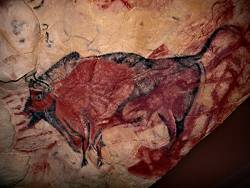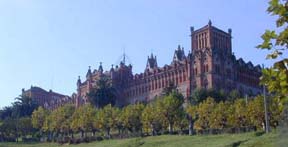Green Spain -- Part Two
Going west out of Santander, the
road turns into a motorway that runs to Oviedo. But
after twenty kilometres you can turn off to the north, along
side roads that take you back to the coast, and the old town
of Santillana. It is one of those strange places which
seem to have had a different life from all its neighbours.
The houses have balconies of wood, and escutcheons sculpted on the walls. As the guide book says, everyone seems to have been an hidalgo, an 'hijo de algo', or 'son of someone'. It is a tourist town, with quaint restaurants, a quiet town square surrounded by sixteenth century houses, wooden balconies everywhere, and massive stone walls, all surrounded by gently undulating countryside of small fields and grazing cows.
But the main attraction is under the fields: the caves of Altamira, which you can no longer visit, but you can, however, visit the museum, which has a representation of the caves. There you can see copies of the famous cave drawings of bison.
Human occupation was limited to the cave mouth although paintings were created throughout the length of the cave. The artists used charcoal and ochre or haematite to create the images, often scratching or diluting these dyes to produce variations in intensity and creating an impression of chiaroscuro. They also exploited the natural contours in the cave walls to give a three- dimensional effect to their subjects. The Polychrome Ceiling is the most impressive feature showing a herd of bison in different poses, two horses, a large doe and what looks to be a wild boar
Further along the coast is the town of Comillas with its large university building on the hill. This is now lying disused, and seemingly abandoned. It is, like so many official buildings in Spain, large, solid, and forbidding, more like a prison with a flashy frontage.
During the sixties, the University was transferred to Madrid, where its doors were opened to a broader range of students.
Further west are salty marshes where the trees have died, leaving white stumps sticking up from the shallow water behind great dunes of sand.
Further west still are the woods, the valleys, and the tiny streams flowing into short estuaries, and then to the sea past great spits of sand. It is like English countryside at its best mixed with southern European beaches at their best.
<<< Part One
The houses have balconies of wood, and escutcheons sculpted on the walls. As the guide book says, everyone seems to have been an hidalgo, an 'hijo de algo', or 'son of someone'. It is a tourist town, with quaint restaurants, a quiet town square surrounded by sixteenth century houses, wooden balconies everywhere, and massive stone walls, all surrounded by gently undulating countryside of small fields and grazing cows.
But the main attraction is under the fields: the caves of Altamira, which you can no longer visit, but you can, however, visit the museum, which has a representation of the caves. There you can see copies of the famous cave drawings of bison.
12,000 years ago the area was inhabited by Stone Age man, and the caves are covered in black and red drawings of bison. Unfortunately a build up of white mould, the result of people breathing in the caves, led to the deterioration of the paintings in the fifties and sixties, and the caves were re- sealed.
Human occupation was limited to the cave mouth although paintings were created throughout the length of the cave. The artists used charcoal and ochre or haematite to create the images, often scratching or diluting these dyes to produce variations in intensity and creating an impression of chiaroscuro. They also exploited the natural contours in the cave walls to give a three- dimensional effect to their subjects. The Polychrome Ceiling is the most impressive feature showing a herd of bison in different poses, two horses, a large doe and what looks to be a wild boar
Further along the coast is the town of Comillas with its large university building on the hill. This is now lying disused, and seemingly abandoned. It is, like so many official buildings in Spain, large, solid, and forbidding, more like a prison with a flashy frontage.
Pope Leo XIII founded the university as a Seminary in 1890 in response to efforts made by the Marquis of Comillas to build an institution for educating candidates to the priesthood. In 1904, the Universidad Pontificia was established when Pope Pius X granted Comillas the power to confer academic degrees in Theology, Philosophy and Canon Law.
During the sixties, the University was transferred to Madrid, where its doors were opened to a broader range of students.
Further west are salty marshes where the trees have died, leaving white stumps sticking up from the shallow water behind great dunes of sand.
Further west still are the woods, the valleys, and the tiny streams flowing into short estuaries, and then to the sea past great spits of sand. It is like English countryside at its best mixed with southern European beaches at their best.
<<< Part One
|
Subscribe
to our email alerts on the housing markets both
in the UK and abroad.
|
HTML Comment Box is
loading comments...
Podcasts:

